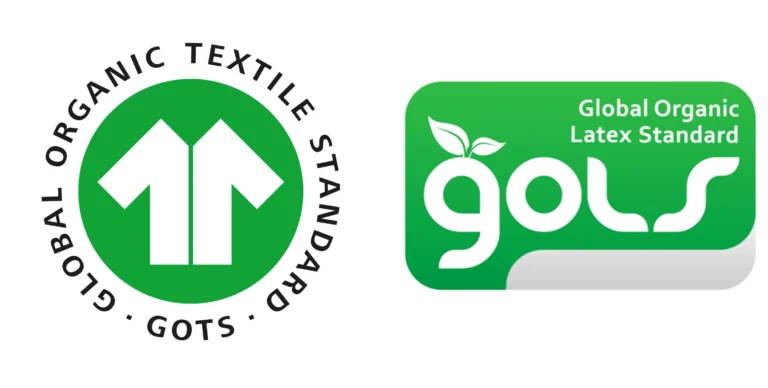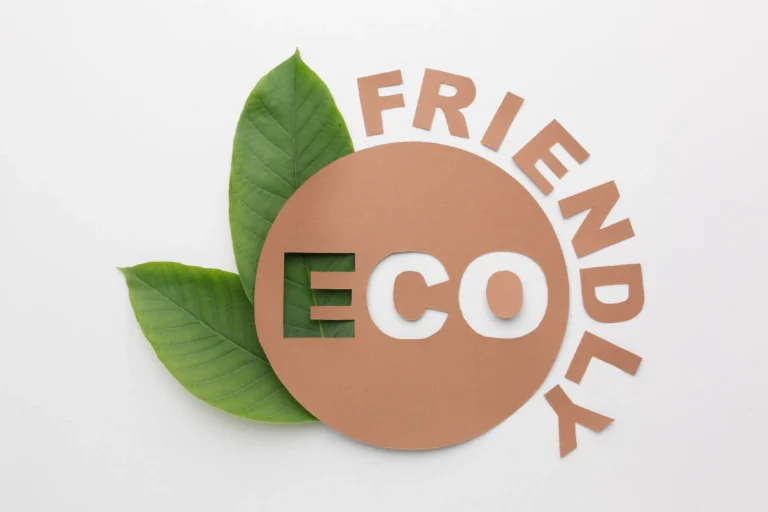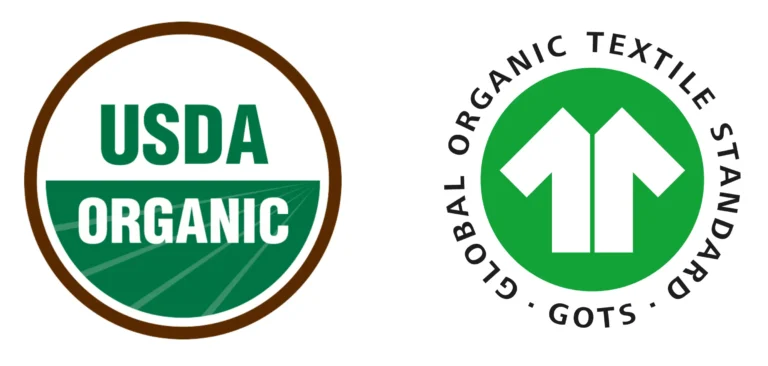Introduction
In recent times, a surge in consumer’s interest toward sustainable, ethically-made and organic products has been noticed. People today are more aware of the environmental and health impacts of conventional practices, which is why they are switching to responsibly-made products. To make these buying decisions easier, several certifications like GOTS, OCS, etc., were introduced. Just one look of their mark on a product’s tag and you’re good to go with your purchase.
However, understanding the nuances between certifications can be daunting. That’s where our take on GOTS vs OCS certification comes into play. We have broken down the details and assure you that these certifications will not only stand by your planet-friendly values but will also make sure that you always invest in mindful choices. Let’s explore OCS vs GOTS certification, their focus, standards, differences and much more.
What is the Difference Between GOTS and OCS?
| Distinctions | GOTS | OCS |
| Scope and Application | GOTS criteria are specifically designed to assess the organic textile material supply chain. It is utilized in diverse textile items such as fibers, yarns, fabrics, infant and adult apparel, as well as bedding and bath textiles, offering a comprehensive benchmark for organic materials. | OCS is more versatile and can be applied to various non-food organic products beyond textiles, such as leather, latex, cosmetics, etc. |
| Minimum Organic Content Requirement | GOTS requires a minimum organic content of 70% in the final product. | OCS has a lower threshold, requiring a minimum organic content of 5%. |
| Comprehensive Criteria | GOTS is considered the most comprehensive organic textile standard as it addresses chemical, environmental, and social aspects to channel a responsible supply chain. | OCS solely focuses on verifying the organic content in the final product without delving into environmental or social considerations. |
| Environmental and Social Responsibility | GOTS stands for sustainable and ethical production practices. Its regulatory requirements address chemical usage by eliminating the consumption of fertilizers during farming, reducing environmental impact by water conservation efforts, and more. GOTS also evaluates the entire supply chain, ensuring fair labor conditions and humane treatment of workers. | OCS’s parameters don’t cover evaluating such aspects. Its primary goal is to authenticate organic fibres claims in the final product, with a more specific focus on the organic material aspect. |
What is GOTS?
The Global Organic Textile Standard or GOTS is one of the world’s most prominent certification bodies in the textile industry for processing natural fibres such as organic cotton. It not only establishes rigorous environmental parameters through organic farming practices but also ensures responsible and clean textile production across the supply chain.
The GOTS certification is recognized as a trusted symbol for top-quality organic cotton as it bans the use of non-GMO seeds, chemical pesticides, and synthetic fertilizers, encouraging cotton cultivation under natural conditions. The certification covers everything from baby and adult garments, bedding and bath textiles, upholstery, personal hygiene products, and textiles designed for contact with food.
GOTS was established by Organic Trade Association (OTA, USA), Internationaler Verband der Naturtextilwirtschaft (IVN, Germany), The Soil Association (UK), and the Japan Organic Cotton Association (JOCA, Japan). The reason for its foundation was to enable textile processors and manufacturers to export their products with a unified, globally acknowledged organic certification. Additionally, its transparency empowers consumers to make better choices, picking truly organic products from an eco-friendly supply chain.
GOTS Certification Requirements
GOTS labels such as “Organic” and “Made with Organic” indicate different percentages of organic fibers for production transparency. “Made with organic” textiles require a minimum of 70% certified organic and natural raw materials, while “Organic” labeled products must have at least 95%.
For GOTS certification, all components of a finished product, from dyes to auxiliaries, must meet strict environmental and toxicological standards. Entire textile supply chains should implement water conservation and wastewater management plans to mitigate the negative impacts of wet processing.
Moreover, GOTS ensures fair trade practices, prohibiting forced or child labor, providing healthy working conditions and guaranteeing the absence of harmful chemical residues and heavy metals, ensuring consumer safety. Companies are also required to steer clear of PVCs for packaging and use eco-friendly choices like recycled or FSC/PEFC-certified paper or cardboard.
Environmental and Social Benefits of GOTS Certification
- The GOTS seal signifies both organic authenticity and commitment to environmental and social responsibility.
- Third-party verification ensures transparency throughout the entire organic supply chain.
- Emphasis on employee well-being, safety, and rights reflects social criteria and ethical business practices.
- Sustainability is reinforced through the GOTS Monitor, overseeing consumption of water and energy.
- GOTS-endorsed chemical inputs adhere to the Manufacturing Restricted Substance List (MRSL) for eco-friendly processing.
- Rigorous scrutiny of accessories identifies and eliminates hazardous chemicals and pesticide residues.
- As a reputed independent certification, it upholds technical quality standards, covering factors like color retention and textile shrinkage.
What is OCS?
The Organic Content Standard (OCS) is an international voluntary certification system established to ensure the integrity of organic raw materials in the textile industry. Formed by the Textile Exchange, the primary focus of OCS is to track and verify organic materials certified to an IFOAM-approved organic farm standard throughout the supply chain. It doesn’t delve into aspects like chemical usage or broader environmental and social considerations; rather, it solely concentrates on evaluating the organic material’s integrity.
OCS is applicable to any non-food product containing a minimum of 5% organic material, verifying a reliable measure of the organic content. By employing the chain of custody requirements from the Content Claim Standard (CCS), the OCS verifies the presence and quantity of organic material in the end product, effectively tracing the flow of raw materials from their source to the final manufactured item.
Objectives of the OCS
In simple terms, the Organic Content Standard (OCS) strives to boost organic agriculture production, and it does so by focusing on three main objectives. Firstly, it serves as a valuable tool for the industry to verify the organic content of the products they acquire. Next, it offers companies a reliable means to communicate claims about organically grown content. Lastly, OCS ensures that organic farmers gain widespread access to the global organic market for their products. Through these initiatives, OCS aims to promote transparency and trust within the industry, benefiting both producers and consumers committed to organic practices.
GOTS vs OCS: Certification Process
GOTS
- Extensive Certification Scope: GOTS guarantees the organic authenticity of the entire textile supply chain, covering processing and manufacturing conditions, packaging, labeling, trading, and distribution.
- Application and Approval Process: Manufacturers apply for GOTS certification by detailing their organic practices and social compliance. Independent certifiers meticulously assess applications to confirm alignment with GOTS standards.
- Certification Commencement: GOTS certification starts with the initial processing step in the textile supply chain. For example, if the originality of organic cotton is to be assessed then the ginning process of cotton will be the starting point.
- On-Site Inspection Rigor: Physical inspections of manufacturing facilities are conducted to verify compliance with organic and social criteria, covering material usage, waste management, and fair labor practices.
- Stringent Ecological and Social Criteria: Each stage in processing, manufacturing levels, and trading must meet strict ecological and social standards to earn the GOTS label, ensuring a commitment to sustainability and ethical practices.
- Certification Decision and Ongoing Monitoring: Certification is granted upon meeting criteria, with continuous monitoring through regular on-site inspections to ensure sustained compliance.
- GOTS Labeling Assurance: Products certified by GOTS proudly feature the GOTS label, serving as a clear indicator to consumers of their adherence to standards for both organic origin and ethical manufacturing practices.
- Compliance and Oversight After Certification: The dedication to GOTS standards extends beyond the certification stage. Following certification, continual efforts in compliance with regulations and monitoring activities are carried on to guarantee that certified entities persist in meeting the environmental and social criteria. This approach preserves the authenticity of GOTS certification in the long run.
OCS
- Application Submission: OCS is a voluntary standard that sets the requirements for third-party certification bodies (GCL, ECOCERT, etc.) to track the amount of organic raw materials in any non-food product. Companies interested in getting the certification can apply on any third-party platform’s online portal. After that, the independent certification body will professionally assess every stage of the supply chain for the certification process.
- Certification Types: OCS offers different certification levels based on the percentage of organic material in the product. The certification categories include OCS 100 (95-100% organic content) and OCS Blended (5-95% organic content).
- Verification Process: OCS certification involves a verification process to confirm the accurate representation of organic content claims. This process includes thorough assessments and audits to maintain traceability of the entire supply chain.
- Certification Decision: Upon successful verification, OCS issues the appropriate certification, providing assurance to consumers regarding the specified organic content in the product.
- Ongoing Monitoring: OCS maintains ongoing monitoring and compliance activities to ensure that certified entities adhere to the organic content standards over time.
- Product Labeling: OCS-certified products can display the relevant OCS label, allowing consumers to easily identify and trust the organic claims made by the manufacturer.
- Global Applicability: OCS provides a globally recognized standard for certifying organic content, facilitating market access for certified products in various regions.
- Chain of Custody Requirements: OCS follows chain of custody requirements, tracing the flow of organic materials from their source through each stage of production, ensuring transparency in the supply chain.
GOTS vs OCS: Consumer Assurance
GOTS
GOTS certification provides consumers with a guarantee of the organic and ethical integrity of textile products. Its holistic commitment to environmental and social standards are designed to trace the entire supply chain, starting from processing the natural fibers to distribution of the finished products. Therefore, consumers opting for GOTS-certified items can trust that the product’s entire lifecycle adheres to rigorous criteria, addressing every factor of fair trade and sustainable practices throughout.
OCS
Organic Content Standard (OCS) focuses specifically on confirming the organic content in finished products. While not as comprehensive as GOTS, this certification is particularly valuable for consumers who prioritize the assurance of organic material origins in their purchases. OCS is applicable to non-food products with 5-100% organic material, providing consumers with confidence in the authenticity of the stated organic content.
Takeaways
As we sum up the match between GOTS vs OCS certifications, we want to emphasize the fact that these certifications serve as a crucial guide for mindful consumers. Yes, the focus and standards of these certifications are different, but their goal remains the same— To help you make a conscious shift towards a greener lifestyle by embracing organic materials. So for everyone who prioritizes sustainability and ethical sourcing, becoming aware of these seals might just be the best thing. Afterall, the significance of OCS vs GOTS extends beyond labels — as they are driven to shape a market for responsibly made products.







Be Good Do Good – Fashion, The Right Way
Get the Be Good newsletter straight to your inbox. Learn about the fashion industry’s burning problems and sustainability tips, as well as new sustainable and ethical brands.